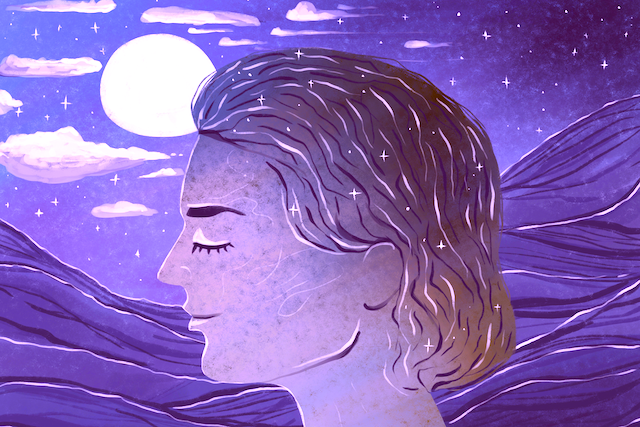Awakening to Impermanence
Reflecting on the fleeting nature of life and the path toward clarity The post Awakening to Impermanence first appeared on Tricycle: The Buddhist Review. The post Awakening to Impermanence appeared first on Tricycle: The Buddhist Review.

Reflecting on the fleeting nature of life and the path toward clarity
By Tarthang Tulku Oct 21, 2024 Photo by Justin Leniger
Photo by Justin LenigerAmong the first of the Buddha’s teachings is that all composite things are impermanent by nature. With the clarity of enlightened omniscience, the Buddha saw that whatever appears to be stable is continually changing. Even what seems most solid and permanent is insubstantial and unreliable: All the conditions and circumstances we count on, whether internal or external, are even now in transition.
Trying to hold onto even one emotion or state of mind is like hoping to grasp a rainbow.
The true import of this statement lies in the major role impermanence plays in our lives. Impermanence is a function of Time, the monster that eats our moments one by one, stealing our pleasures and consuming our energy. Trying to hold onto even one emotion or state of mind is like hoping to grasp a rainbow: Our mental and emotional states change even before we can identify and respond to them. Again and again, we tell ourselves that what we value—our health, our friends, our youth, our work—will last, but gradually time strips them all away. As the years go by, relationships come to an end, family ties dissolve and take on new configurations, physical vitality declines, and opportunities become more elusive.
Despite the steady evidence of the senses and our past experience, we never quite learn to accept impermanence. We still hope that somehow we can hold on to what we have. We make a new friend or take a new lover and refuse to admit that one day we may be bitter enemies. We refuse to believe we will grow old, and yet, as if by some evil magic, the signs of age that once seemed only to affect others suddenly begin to affect us. Childhood deserts us before we even have a chance to enjoy it; youth is gone before we know it. Lines appear on our face; first one gray hair emerges and then another. Although we may try to ignore or camouflage the subtle signs of age that creep up on us, the nature of impermanence ensures that youth inevitably passes away, and we progress steadily into old age.
The most devastating example of impermanence is death. By the time we reach adulthood, the inevitability of death has become obvious, but still, we try to hide from the knowledge that we will die. Perhaps we hope that by making ourselves look and act young, death will pass us by. The Western emphasis on youth presents a great barrier to dealing honestly with impermanence and our inevitable death.
Thus it is vital to awaken to the implications of impermanence and to see that the reality of continual change points to the uselessness of following the desires of this life. Friends turn to enemies, enemies to friends. Lovers will not last. Wealth and fame are ephemeral. Everything in the world is undependable. With this knowledge, it becomes clear that giving the Bodhisattva path priority over family and friends is the greatest demonstration of love. Only if we give up the impermanent things of this life can we become Awakened, and only if we become Bodhisattvas can we be of genuine help to others.
The truly important transitions in our life, including the final transition of death itself, come to us when we are alone. In those moments, what resources will we have to sustain us? How can we prepare ourselves now for what is sure to come eventually?
Turning Toward Practice
The starting point of spiritual practice is to reflect on how valuable it is to be alive and to see clearly the possibilities that life offers us. If we can understand our own nature and appreciate this opportunity to make our lives truly meaningful, we can learn to take full advantage of each moment. Instead of attempting to cling to the past or control the future, we can make the present moment richer and healthier. Reflecting that whatever we hold dear will one day disappear, we can turn to the events of our lives with a clarity and commitment that help us and help others as well. Change is certain; death will come. Seeing this, we know that we must take life seriously. Instead of waiting helplessly for an unknown destiny, instead of wasting our time on pleasures that dissipate and turn sour, we can turn inwards and learn the nature of our minds.
Change is certain; death will come. Seeing this, we know that we must take life seriously.
Perhaps this sounds selfish, but it is a realistic response to an extreme situation. The past is only a memory; the future will never turn out as we expect. Will we leave this present moment with empty hands? If we seek security, we are sure to end up in frustration; if we fail to appreciate our present opportunities, each chance for realization will slip through our fingers. In the midst of chaos and confusion, can we find the clarity to recognize what has value? Can we see through the patterns of hope and fear and turn our minds to the possibility of enlightenment?
Leaving behind the concerns of this life is to accept the futility of preparing for the future as well. Such a total acceptance of impermanence, however, is only for those who are willing to accept the consequences: If you are living in a cabin in the wilderness and you do not gather firewood for winter, death may indeed be the result. On the other hand, even if you gather firewood, you cannot be certain you will live to enjoy the fire.
◆
 Photo by Dharma Publishing
Photo by Dharma PublishingFrom Path of Heroes: Birth of Enlightenment by Zhechen Gyaltsab Padma Gyurmed Namgyal: with the practice instructions and reflections of Tarthang Tulku. Translated by Deborah Black, © 1995 by Dharma Publishing.
![]()
Thank you for subscribing to Tricycle! As a nonprofit, we depend on readers like you to keep Buddhist teachings and practices widely available.
This article is only for Subscribers!
Subscribe now to read this article and get immediate access to everything else.
Already a subscriber? Log in.

 ValVades
ValVades 































